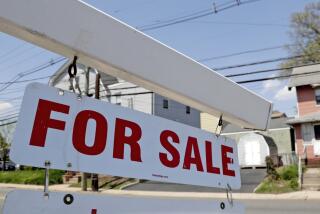Cash-strapped borrowers gain time to improve credit, equity
The Treasury Department and a consortium of lenders and investors on Thursday announced a relief plan intended to help some sub-prime borrowers. Who qualifies for the relief and what type of help should they expect? Here are some answers.
Why was the plan created?
In an effort to lessen a projected tidal wave of foreclosures as an estimated 1.8 million adjustable-rate sub-prime mortgages reset to higher interest rates during the next two years, regulators and industry leaders came together to work out a plan to temporarily freeze the rates on about one-third of these loans.
Why are only a third of the loans eligible for a rate freeze?
The consortium that negotiated the deal believes that about 600,000 borrowers can refinance without trouble and another 600,000 can’t make their payments even at current rates, so they’re likely to need individual help if they’re going to avoid foreclosure. It’s only the remaining segment that qualifies for the rate-freeze plan.
What does the plan do?
It freezes the borrower’s current mortgage rate for five years. After that, the borrower would need to get a new loan or pay the higher rate, as originally contracted.
Why five years?
Promoters of the plan believe that period will give borrowers time to build credit and equity and thus be left in a better position to refinance. It also gives the real estate market time to recover so, presumably, borrowers who want to refinance won’t get rejected for having too little equity in their homes.
Who qualifies for the rate freeze?
First, the residence must be owner-occupied. The borrower must be no more than 30 days late on his or her mortgage payments and have a FICO credit score of 660 or less. The loan must have been originated in January 2005 to July 2007 and have an initial reset date of January 2008 to July 2010. Also, the borrower must have less than 3% equity in the home.
What if I have a better credit score or more equity in my home?
You probably won’t qualify because lenders believe you can refinance. Those who can qualify for a new loan, either through a private lender or the Federal Housing Administration, are expected to do so.
If I meet the criteria, what do I have to do to get a rate freeze?
Call your lender. Lenders are attempting to identify customers who qualify for the plan and proactively contact them. Still, they urge borrowers to call because not all the necessary information is in their files.
Can my lender refuse to freeze my rate if I qualify under this plan?
Yes. This is an industry initiative, not a law. Participation is recommended but not mandatory. If your lender is not participating, your best option may be to try to refinance your loan.
I’ve been paying interest only during my loan’s low “teaser” rate period. Will the plan allow me to continue paying interest only or do I have to start paying principal now?
The industrywide plan is silent on this issue, which means it’s likely to be decided on a case-by-case basis.
Can you show how the numbers would work out on a real loan?
The typical sub-prime loan was made at a teaser rate of about 5.99%, according to Jeff Lazerson, president of Mortgage Grader. Reset rates would be based on an index, such as the London Interbank Offered Rate (which was at 4.423% on Thursday), plus a margin of 4 to 8 percentage points.
For purposes of example, Lazerson figures this loan would have a 5.99-percentage-point margin, bringing the reset rate to 10.413%.
On a $100,000 loan, the borrower’s current monthly payment would be $499.16 if he were paying interest only. If he must pay principal and interest, the monthly payment would be $598.90.
If the borrower could not qualify for the rate freeze and his rate reset Thursday, his monthly payment would jump to $908.24, paying principal and interest, Lazerson said.
What about people who have to refinance? What are they facing in terms of rates?
The good news is that conventional mortgage rates have declined sharply in recent months. Thus, a borrower could get a 30-year fixed FHA loan at 5.875% on Thursday, Lazerson said.
The borrower, however, would have to pay closing costs and mortgage insurance. FHA mortgage insurance comes in two parts: a 1.5% fee paid upfront and monthly mortgage insurance payments of 0.5% of the loan amount.
Lazerson figures the combination of closing costs and upfront FHA insurance premiums would run 3.5% and be added to the balance of the loan.
So, our hypothetical borrower would now have a $103,500 loan. His monthly payment would work out to $612.24 in principal and interest, plus $43.12 in mortgage insurance payments. Total: $653.36. That amount does not include impounds for taxes and property insurance.
I have a prepayment penalty on my current loan, which is why I haven’t refinanced. Will lenders forgive those penalties under this plan?
Lenders are being encouraged -- not forced -- to waive prepayment penalties or stall refinances. Lenders will make decisions on a case-by-case basis.
How do I find out if I qualify for a rate freeze or some other help?
Call your lender. Or call the credit counseling network that is working with the lending industry. That number is (888) 995-HOPE.
When trying to reach your lender, “call early and often because the squeaky wheel gets attention and lenders are going to be overwhelmed by the volume of this,” Lazerson said.






